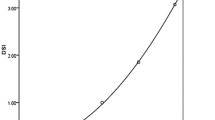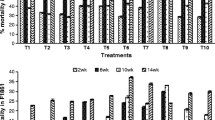Abstract
The potential impact of three widely used herbicides, pendimethalin, prometryn, and trifluralin, on populations of five plant disease suppressing bacterial isolates (three isolates of Pseudomonas fluorescens and two isolates of Burkholderia cepacia) in the rhizosphere of cotton seedlings was investigated. All isolates are efficient cotton root colonizers and each is capable of suppressing a plant disease. In microcosm experiments, application of each of the test herbicides at the rates of 1, 2, and 4 µg active ingredient (a.i.) g-1 soil caused significant (p<0.05) reductions in populations of most of the isolates in the rhizosphere, 14 days after the release of bacteria into the soil by seed coating. The responses of the isolates to the herbicides varied depending on the isolate and the type and concentration of the herbicides. In microcosm experiments the impact of pendimethalin, prometryn, and trifluralin at the respective concentrations of 2.4, 3.6, and 1.8 μg a.i. g-1 soil on the population of isolate D1 in the cotton rhizosphere declined with time during a four week period of monitoring following the release of the isolate into the soil by seed coating. The impact of soil applied test herbicides on the population sizes of D1 in cotton rhizosphere was also studied in two field experiments (Safford and Tucson, Arizona) where the bacteria were added as a soil drench. In the Safford experiment pendimethalin and prometryn, but not trifluralin, caused significant (p <0.05) reductions in the population of the bacterium 15 days after sowing. In the Tucson experiment a significant (p < 0.05) reduction in the population of the bacterium was observed 15 and 25 days after sowing in soils treated with pendimethalin and prometryn and 25 days after sowing in soils treated with trifluralin.
Similar content being viewed by others
References
Ahmad I, Bissett J and Malloch D 1995 Influence of the bioherbicide phosphinothricin on interactions between phytopathogens and their antagonists. Can. J. Bot. 73, 1750–1760.
Altman J and Campbell C L 1977 Pesticide-plant disease interactions. Effect of cycolate on sugar beet damping-off induced by Rhizoctonia solani. Phytopathology 67, 1163–1165.
Altman J and Rovira A D 1989 Herbicide-pathogen interactions in soil-born root diseases. Can. J. Plant. Pathol. 11, 166–172.
Atlas R M, Pramer D and Bartha R 1978 Assessment of pesticide effect on non-target soil microorganisms. Soil. Biol. Biochem. 10, 231–239.
Brown S L 1979 Rhizosphere effect of herbicide-stressed sickle-pod (Cassia obtusifolia) on Fusarium oxysporum f. sp. vasinfectum. MS thesis. Auburn Univ., Auburn, AL. 74 p.
Bull C T, Weller D M and Thomashow L S 1991 Relationship between root colonization and suppression of Gaeumannomyces graminis var. tritici by Pseudomonas fluorescens strain 2-79. Phytopathology 81, 954–958.
Cook R J and Baker K F 1983 The Nature and Practice of Biological Control of Plant Pathogens. APS press, St. Paul, MN. 539 p.
Filippi C, Bagnoli G, Volterrani M and Picci G 1987 Antagonistic effects of soil bacteria on Fusarium oxysporum f. sp. dianthi, (Prill and Dell). Synd. And Hans. III. Relation between protection against Fusarium wilt in carnation and bacterial antagonists colonization on roots. Plant Soil 98, 161–167.
Forlani G, Mantelli M, Branzoni M, Nielsen E and Favilli F 1995 Differential sensitivity of plant-associated bacteria to sulfonylurea and imidazolinone herbicides. Plant Soil 176, 243–253.
Gaylor M J, Buchanan G A, Gilland F R and Davis R L 1983 Interactions among a herbicide program, nitrogen fertilization, tarnished bug plants, and planting dates for the yield and maturity of cotton. Agron. J. 75, 903–907.
Greaves M P and Sargent J A 1986 Herbicide-induced microbial invasion of plant roots. Weed Sci. 34 (Suppl. 1), 50–53.
Grossbard E 1985 Effect of glyphosate on the microflora: with reference to the decomposition of treated vegetation and interaction with some pathogens. In The Herbicide Glyphosate. Eds. E. Grossbard and D Atkinson. pp 159–185. Butterworth and Co., London.
Mekwatanakarn P and Sivasithamparam K 1987 Effect of certain herbicides on soil microbial population and their saprophytic growth in soil and pathogenicity of take-all fungus. Biol. Fertil. Soils 5, 175–180.
Misaghi I J, Olsen M W, Billotte J M and Sonoda R M 1992 The importance of rhizobacterial mobility in biocontrol of bacterial wilt of tomato. Soil Biol. Biochem. 24, 287–293.
Moorman T B and Dowler C C 1991 Herbicide and rotation effects on soil and rhizosphere microorganisms and crop yield. Agric. Ecosys. Envion. 35, 311–325.
Moorman T B 1989 A review of pesticide effect on microorganisms and microbial processes related to soil fertility. J. Prod. Agric. 2, 14–23.
Mudd P J, Greaves M P and Wright S J L 1985 Effect of isoproturon in the rhizosphere of wheat. Weed Res. 25, 423–432.
Raaijmakers J M, Leeman M, van Oorschot M M P, van der Sluis I, Schippers B and Baker P A H M 1995 Dose-response relationship in biological control of Fusarium wilt of radish by Pseudomonas spp. Phytopathology 85, 1075–1081.
Rodriguez-Kabana R and Curl E A 1980 Nontarget effects of pesticides on soilborne pathogens and diseases. Annu. Rev. Phytopathol. 18, 311–332.
Rovira A D and McDonald H J 1986 Effect of the herbicide chlorsulfuron on Rhizoctonia bare patch and take-all of barley and wheat. Plant Dis. 70, 879–882.
Schroth M N and Hancock J G 1981 Selected topics in biocontrol. Annu. Rev. Microbiol. 35, 453–476.
Sprague M A and Triplett G B (eds.) 1986 No-tillage and Surfacetillage Agriculture. The Tillage Revolution. JohnWiley and Sons, New York, 467 p.
Weller D M 1988 Biocontrol of soil-born plant pathogens in the rhizosphere with bacteria. Annu.Rev. Phytopathol. 26, 379–407.
Author information
Authors and Affiliations
Rights and permissions
About this article
Cite this article
Heydari, A., Misaghi, I. & Mccloskey, W. Effects of three soil-applied herbicides on populations of plant disease suppressing bacteria in the cotton rhizosphere. Plant and Soil 195, 75–81 (1997). https://doi.org/10.1023/A:1004299632566
Issue Date:
DOI: https://doi.org/10.1023/A:1004299632566




